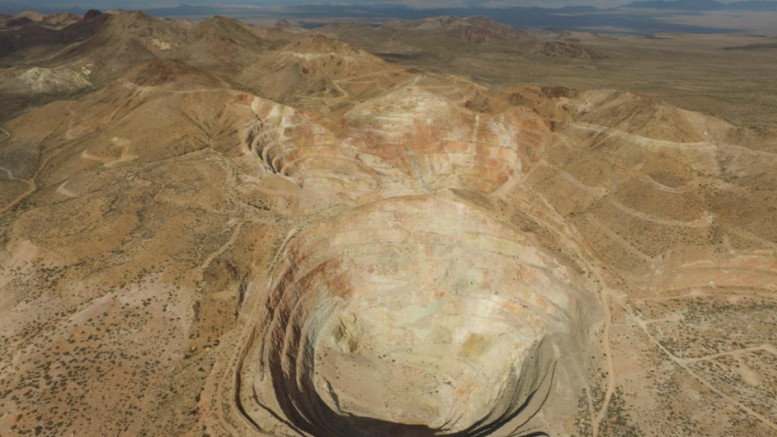VANCOUVER — Just three months after merging with Catalyst Copper, aspiring gold miner NewCastle Gold (TSXV: NCA; US-OTC: CTMQF) is already churning out drill results at its flagship past-producing Castle Mountain gold project located 90 km south of Las Vegas in southern California’s San Bernardino County.
The best drill hole intercept from the project’s South Domes deposit returned 1.09 grams gold per tonne over 213.7 metres, including 4.14 grams gold over 16 metres. Just under half of the mineralized intercept falls outside of the property’s measured and indicated resources.
The company also found 0.72 gram gold over 16.8 metres in a drill hole outside the modelled pit shell, from a new target that runs parallel to South Domes.

Plan map of South Domes with latest drill results. Credit: NewCastle Gold.
Newly appointed president and CEO Gerald Panneton tells The Northern Miner during a phone interview that the current drill campaign, which has been doubled to 20,000 metres, is part of the company’s larger strategy to bring the project back into production.
NewCastle has a conditional-use permit and reclamation plan — valid until 2025 — that allows for open-pit mining of up to 8 million tonnes per year, with no pit back-full requirements. It also has the rights to 10 water wells, with two operating.

Looking northeast over the backfilled JSLA pit at NewCastle Gold’s historic Castle Mountain gold project in southern California’s San Bernardino County. Credit: NewCastle Gold.
“We could go back to mining in six or 12 months, but we want to be careful about it. You don’t want to build a waste dump, leach pad or process plant on areas that are amazing for exploration. There are a lot of targets that we still want to test, and South Domes is certainly one of them.”
Castle Mountain was the site of an open-pit, heap-leach operation that produced 1.24 million oz. gold at a 1.47-gram-gold head grade from 1991 to 2001, when mining was suspended due to low gold prices.

Cross-section view of South Domes target with latest drill results. Credit: NewCastle Gold.
Since NewCastle acquired a 100% interest in the property four years ago, the company has drilled 21,500 metres, mostly within the historic open pits.
Last December, it updated the resource estimate for the project to 220 million measured and indicated tonnes of 0.59 gram gold for 4.1 million oz. gold.

“My role in the project is to help bring it to the finish line, just as I had done with Detour Gold.”
Gerald Panneton
President and CEO,
NewCastle Gold
Inferred resources tack on 40.8 million tonnes grading 0.58 gram gold for 760,000 oz. gold.
Panneton says the merger with Catalyst — a copper vehicle that was helmed by mine financiers Richard Warke and Frank Giustra — was the next step towards advancing the project.
“The work that NewCastle did was very good quality, but they didn’t have any money to drill, and the merger helped bring that work forward,” Panneton says.
Castle Mountain hosts a cluster of disseminated, low-sulphidation epithermal deposits that extend almost continuously for more than 2.5 km along strike.
The groundwork for gold mineralization began 18 million years ago, when an active volcano emptied its magma chambers and collapsed upon itself. The hydrothermal breccias and fracture zones that were created later acted as permeable conduits for gold-rich fluids to ascend and concentrate.
Structural interpretations, completed over the past year by NewCastle’s former management suggested that some mineralization at Castle Mountain may be more vertically oriented than others.

Gravity lows at Castle Mountain (areas of blue in figure on left) identifies structural boundaries that host known resources (blue, yellow, red), whereas rock samples (triangles) coincide with newly-identified structures. Blue-dashed circles represent areas of potential resource expansion. Credit: NewCastle Gold.
Panneton says previous exploration at South Domes may have missed these zones, as work consisted mainly of vertical, reverse-circulation drill holes that rarely went beyond 250 metres deep.
“The previous management did a wonderful job pushing the geological model to a new level, and the results of this current drill program are testament to that,” he says. “There’s more than just one mineralizing system at South Domes, and it’s opening up new territory for us to expand our resource there.”
Before joining NewCastle, Panneton was the founder, president and CEO of Detour Gold (TSX: DGC; US-OTC: DRGDF). Under his leadership, the company’s Detour Lake gold project, 300 km northeast of Timmins, Ont., grew from 1.5 million oz. gold in resources to 16 million oz. in reserves.

A drill rig at NewCastle Gold’s historic Castle Mountain gold project in southern California. Credit: NewCastle Gold.
Panneton became interested in Castle Mountain because he saw it as the next gold mine he could develop.
“I didn’t join the company because I thought the project was mature, I joined because I knew the project has great potential, it’s just a matter of drilling and understanding the geological model,” he says. “My role in the project is to help bring it to the finish line, just as I had done with Detour Gold.”
Shares of NewCastle have traded in a 52-week range of 18¢ and $1.16, and closed at $1.02 at press time. The company has 157.5 million shares outstanding for a $166-million market capitalization.


Be the first to comment on "NewCastle explores for more at Castle Mountain"